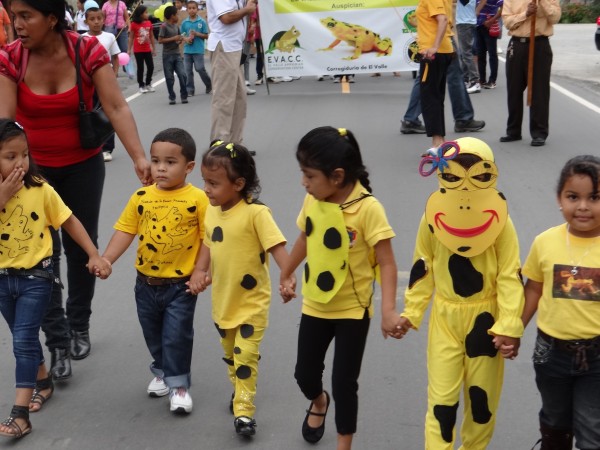A quick video overview of the Panama Amphibian Rescue and Conservation Project. Thanks so much to all our valued supporters and volunteers for your help and generous donations. To see our 2011 annual report click here.
Category Archives: ex-situ conservation
A Successful Golden Frog Day in Panama
August 10th through August 13th marked the celebration of Golden Frog Day for the Panama Amphibian Rescue and Conservation Project. The week prior, the entire staff worked hard to put together a unique experience for visitors in Panama. STRI researchers in nearby Gamboa captured túngara frogs, Savage’s thin-toed frog, gladiator frogs, leaf frogs and glass frogs for public display. Everyone took turns blowing up hundreds of yellow and black balloons. Without such team effort, we would not have been able to pull off this event.
The rescue project does not have any actual specimens of the golden frog, Atelopus zeteki, and because the species is extinct in the wild, we were repeatedly asked where the golden frogs are. This allowed for us to discuss the importance of amphibian conservation and of the rescue project, EVACC and other amphibian conservation efforts around the world. Staff members educated visitors about the frogs that were on display, and scientists studying tungara frogs in Gamboa set up a small exhibit to educate the public about the research being conducted by STRI scientists.
Seeing children become so enthused about frogs instills a wonderful feeling in a herpetologist. Over the course of the weekend, nearly 1,000 children visited the event. Every day there was an activity station set up for the kids to paint frog masks, and winners were selected from each group. On Saturday, we had use of a bouncy house and bungee race, which undoubtedly led to many tired kids (and grateful parents). But the highlight of the children’s day was always the frogs. Tiny faces lit up and smiled time and time again every time they saw the tadpoles swimming, the túngaras hopping, or even just the size of the sedentary Savage’s thin-toed frog.
Events like the one held that weekend demonstrate the importance and effectiveness of educational outreach. 1,000 children over the course of three days (along with uncounted adults and family members) mean that the rescue project was able to spread the word out about the necessity of preserving biodiversity. The fact that this weekend was dedicated to the golden frog, a national symbol of Panama that now exists only in captivity, underscores the urgency to address worldwide amphibian declines.
We thanked MEDUCA (Ministry of Education) who made it possible for 310 students to visit; Aid4Aids staff; kids and parents who made our Saturday an unforgettable day; all the staff at Summit Municipal Park, especially to: Melgar, Itzel and Adalberto. Lastly, a special thanks to the volunteers (Ximena, Jesse, Laura, Kristen, Jennifer, Jose Maria, Meghan, Andrew, Kelsey, Shanta, Natalie, Ana, Giancarlo, Alexis, Sangie, Dania, Anayansi, Kristel, Digna and Katherine) who helped keep everything flowing in an orderly manner the entire weekend!
—Norman Greenhawk, rescue project volunteer; and Angie Estrada, rescue project coordinator
Happy Third Annual Golden Frog Day!
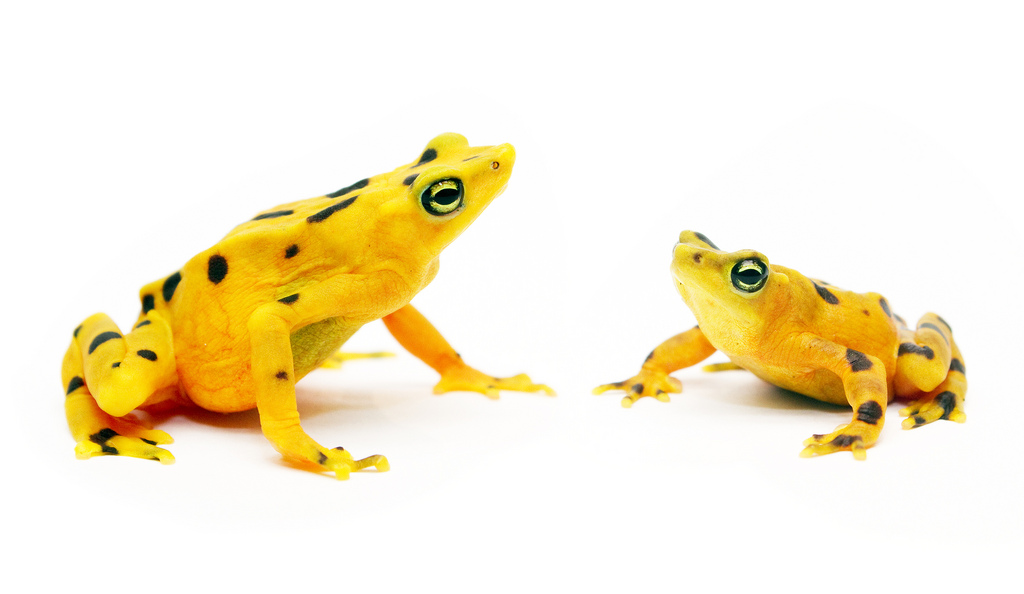
In 2010, the National Assembly of Panama passed a law that honors the significance of one of the most striking amphibian species, the Panamanian golden frog. That day is Aug. 14. (Photo by Brian Gratwicke, Smithsonian Conservation Biology Institute)
It’s National Golden Frog Day in Panama today and we’re celebrating here on the blog with some thoughts from the rescue project’s partners and other stakeholders about what the golden frog means to each of us individually, to Panama’s culture, to the ecosystem and to the world:
Adrian Benedetti, Smithsonian Tropical Research Institute
“The golden frog was the first animal to capture my imagination when I returned to Panama after living abroad for 12 years. The fact that this little animal had such a grip on local myth and legend makes it almost magical.”
“La Rana Dorada fue el primer animal en capturar mi imaginación al regresar a Panamá después de 12 años de estar fuera del país. El hecho de que este animalito ha tenido un impacto tan grande en la mitología y leyenda local lo hace casi mágico.”
Brian Gratwicke, Smithsonian Conservation Biology Institute
“I actively search for a little glimmer of neon-yellow peeking out from behind a rock every time I hike up a river in El Valle de Anton, but I’m always disappointed. I guess I’m chasing that same ecstatic rush that people get when they twitch a new bird species, or see a grizzly bear catching a salmon in Alaska. I think anyone who has seen charismatic wildlife in wild, natural landscapes where they belong can understand why it would be so thrilling to play a small role in bringing golden frogs back from the brink.”

In the market at El Valle de Antòn, you will see golden frogs by the thousands either as enamel-painted terracotta or on hand-carved tagua nuts. (Photo by Brian Gratwicke, Smithsonian Conservation Biology Institute)
Edgardo Griffith, EVACC
“The only reason golden frogs and other species are going extinct is because of us. We are the ones that created the problems they and their habitats are facing, so we are the ones that have to find the solutions. It is our responsibility big-time, especially because the more responsible we are with the environment, plants and animals, the more chances of survival the future generations of our own kind will have. In my opinion, saving wildlife today is the only way we have to assure the survival of our very own species.”
“I recognize that not all amphibians are physically beautiful, but I love them all and consider all of them master pieces of DNA. However, the Panamanian golden frog is indeed colorful, elegant and very wise. Knowing a little bit about their natural behavior makes me appreciate them even more. I think they are one of those things where Mother Nature just went overboard.”
Heidi Ross and Edgardo Griffith, EVACC
“The golden frog is the most significant, important and charismatic amphibian in Panama. It is part of our culture and a very important member of the amphibian community. From an ecological point of view, it is one of those species that is extremely susceptible to even minimal environmental changes. It is also a species that has been used as a flagship to conserve other amphibian species.”
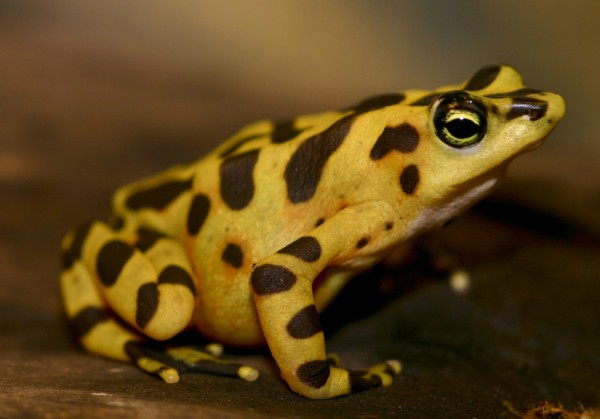
Panamanian golden frogs are extinct in the wild, but a number of zoos have successful breeding programs that aim to keep the species alive. (Photo by Brian Gratwicke, Smithsonian Conservation Biology Institute)
“To witness an entire population disappear is just devastating, and heartbreaking. Now every time we go back to the sites where we used to work with golden frogs, all we do is remember where we used to find them and imagine what it would be like to hear their characteristic whistle-like call again. But after a few hours of not finding them, or hearing them at all, a horrible feeling of void and silence fills us up. This is the time to get out of there. In other words, it is sad, very sad to know that they are all gone now, just like living the worst day of your life over and over again. That is how it feels to go to the field now. They are some of the many ghosts of the stream now.”
Mason Ryan, University of New Mexico
“This frog is such an important symbol to Panama and now the entire conservation community that saving them is our responsibility. They are colorful, have neat behaviors, and are overall captivating. Future generations should have the joy and wonderment of seeing these frogs.”
“I spent five years looking for a closely related species in Costa Rica, the Harlequin frog, and never found one. I never dreamed I would have the opportunity to see any frogs of the genus Atelopus. But then I started my first field season at El Cope with Karen Lips. Early in the season we were walking one of the main streams in the park and there it was. An adult golden frog hopping along the bank of the stream. It was a magical experience to see this golden frog with block spots in real life! I am pretty sure I was smiling the next two days. It was a dream come true to see one of these animals in its natural habitat. Over the years I saw dozens more and never tired of seeing them. I’ll never forget that first one.”
Matt Evans, Smithsonian’s National Zoo
Panama’s National Golden Frog Day Events 10-19 August, 2012
Golden Frog Day is a national day of awareness in Panama that occurs annually on August 14th. This day was designated in 2010 to celebrate the Panamanian golden frog and promote amphibian conservation. Here is a detailed agenda of the many activities next week, in Spanish and translated into English below:
10-12 August: Summit Municipal Park, Panama City
- Temporary frog exhibit and presentations by researchers
- Student visits coordinated with the Ministry of Education (MEDUCA)
- Recreational activities, face painting and games
- Info: 6597-0768 parquesummit@gmail.com
14 August NATIONAL GOLDEN FROG DAY
- Public Forum:“The cultural impact and state of conservation of the Golden Frog and other Panamanian amphibians”
- Presentations by: Richard Cooke, Edgardo Griffith, Roberto Ibañez
- Earl S. Tupper Research and Conference Center, Smithsonian Tropical Research Institute, Panama City. 6:00 PM
- Info: 212 81 11 tejadas@si.edu
17 -18 August: El Nispero Zoo, El Valle de Antón – 7AM- 5PM
- Golden Frog Parade,10:00 AM, EL Valle de Antón
- Cultural Celebration, all afternoon, Friday 17 August
- Visit the Golden Frog exhibit at the Zoo.
- Student activities focused on conservation
- Info: 6676-8094 egriffith23@hotmail.com
19 August: Punta Culebra Nature Center, Amador Causeway, Panama
- Sand sculpture contest
- Activities for the whole family
- Presentations by experts
- Creativity zone and games
- Info: 212 8793 puntaculebra@si.edu
Precious Pirre
Cute Frog of the Week: July 30, 2012
This frog is ready to brighten your day! With bluish stripes and yellow feet this Pirre harlequin frog (Atelopus glyphus) is especially striking. Adults are brown and look like they have had Jackson Pollack splatter them with yellow paint. This critically endangered frog is found in protected areas in Colombia and Panama. While Pirre harlequin frogs live in tropical forestland, their tadpoles stay in swift-moving streams. These tadpoles have large suckers that help them cling onto underwater rocks and graze on diatoms and stream algae.
The Pirre harlequin frog is one of the rescue project’s priority rescue species. The program started with 20 pairs that have now bred twice and we now house 75 juvenile frogs like the one above. The project’s goal is to reach 500 frogs total with representation from each founding pair of animals, as chytrid and habitat loss continue to decimate the population in the wild, making individuals difficult to find. Frogs from the Atelopus genus are among the most threatened in the world.
Photo by Brian Gratwicke, Smithsonian Conservation Biology Institute.
Every week the Panama Amphibian Rescue and Conservation Project posts a new photo of a cute frog from anywhere in the world with an interesting, fun and unique story to tell. Be sure to check back every Monday for the latest addition.
Send us your own cute frogs by uploading your photos here: http://www.flickr.com/groups/cutefrogoftheweek/
Celebrating tadpole diversity
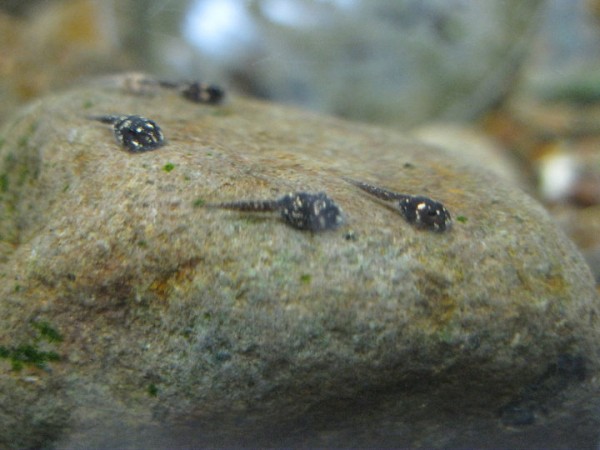
The ability of certain Panamanian species to survive will depend on the ability of the rescue project to perfect specialized care for the individual species. (Photo by Lindsay Renick Mayer, Smithsonian
When we talk about frog diversity, we always mention how many species there are, or how they are found all over the world. We say how much frogs vary in size, or how colorful they can be. This is all true: there are more than 4,900 frog species, found on every continent, ranging from ½-inch long to more than a foot, that come in every color of the rainbow. It makes sense, then, that frogs are just as diverse during their other stages of the life cycle. Tadpoles, in fact, are among the most diverse vertebrates on Earth and are themselves morphologically and behaviorally unique from their adult counterparts.
Special Adaptations
Depending on the species, tadpoles can stay in the larval stage from eight days to two years, and vary in length from 1 to 4 inches. Overall, there is greater tadpole diversity in the tropics, but variations occur within habitats, as well. Even tadpoles with the same feeding habits can have diverse mouth shapes or behaviors. For example, tadpoles of the Asian horned frog (Megophrys montana) have an upturned mouth because they eat from the surface. Recently, however, scientists have observed a Honduran tadpole called Duellmanohyla soralia that also eats from the surface, but has a mouth in the more traditional spot. Instead, the Duellmanohyla soralia turns its body upside-down to reach the surface.
“We see tadpoles solving the same problems of survival in different ways,” says Dr. Roy McDiarmid, an amphibian zoologist and tadpole expert at the National Museum of Natural History. “This is where their diversity derives from.”
These variations show how tadpoles’ features are shaped largely by their surrounding environments. For example, tadpoles seem especially good at responding to strong predator presence. Over time tadpoles can grow their tails longer and deeper if there are numerous predators, allowing them to swim faster and look bigger. For European common frog (Rana temporaria) tadpoles, longer tails increase their chances of escape from predators up to 30 percent, according to the Institute of Zoology.
Like tail length, other adaptations can protect tadpoles from being eaten. While the majority of tadpole species have brown or faded coloration, several are multicolored. Contrary to its name, Cope’s gray tree frog (Hyla chrysoscelis) tadpoles grow red tails in response to the presence of dragonflies. Called aposematism, vibrant colors make these tadpoles appear larger or distasteful to their predators.
Researchers have only recently discovered other survival mechanisms that tadpoles have developed. In 2006, scientists discovered that if attacked, red-eyed tree frog (Agalychnis callidryas) embryos can hatch themselves within seconds and escape into the water below. These embryos can interpret vibrations on the water with astonishing precision.
“It turns out that when a snake bites into a gooey mass, all the embryos try to wiggle free,” Karen Warkentin, a biologist working at the Smithsonian Tropical Research Institute in Panama, told National Geographic. “A wasp’s more focused attack prompts only neighboring eggs to hatch. And a rainstorm triggers nothing at all.”
Other recent research has looked at tadpole sensory input, such as smell and sound. In 2009, researchers at the University of California Davis determined that wood frog (Rana sylvatica) tadpoles can “smell” their primary predator, the salamander. The “odor” of a salamander in the water caused tadpoles to freeze. The strength of the scent determined how long the tadpoles remained still. In 2010, Dr. Guillermo Natale discovered the first evidence of aural larva communication. Natale heard tadpoles of the Bell’s horned frog (Ceratophrys ornate) “screaming” underwater when a threat was present.
Discovery
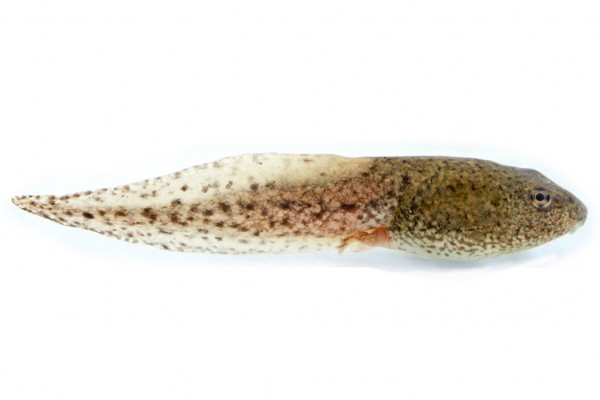
The amount of tadpole diversity rivals that of their adult life forms. (Photo by Brian Gratwicke, Smithsonian Conservation Biology Institute)
New and unpredictable tadpole discoveries continue to go on worldwide. For example, biologists at the Australian Museum in Sydney recently discovered that tadpoles of the vampire flying frog (Rhacophorus vampyrus) have small black fangs, instead of traditional mouthparts. In general, scientists estimate that more than 1,000 frog species have yet to be discovered, not to mention all the intricacies of their life stages.
Tadpoles are also essential for understanding the dramatic decline in frog populations. Chytrid, the epidemic that has affected 30 percent of the world’s amphibian population, is the lead cause of this decline. In tadpoles, chytrid only infects the keratin around their mouths. However, as they metamorphose into frogs, chytrid fatally spreads throughout their bodies. By studying tadpoles, we can better understand how frogs contract and carry chytrid.
“When frog species are disappearing like they are, you would want to know what’s going on at each stage of the life cycle, egg to larva to juvenile to adult–everything,” McDiarmid says.
The Challenges of Breeding
For the Panama Amphibian Rescue and Conservation Project, every tadpole means the chance for a species to survive. But because many of the rescue project’s priority species have never been kept or bred in captivity before, rearing tadpoles can mean a steep learning curve.
“Breeding frogs isn’t just about putting a male and female together and hoping for eggs,” said Lindsay Renick Mayer, spokesperson for the rescue project. “It’s about specialized husbandry for each individual species among a diverse array and unfortunately for some of these species we’re learning those skills even as the species dwindles down to just a few remaining individuals. Whether these species are one day returned to the wild depends on the rescue project’s success in perfecting the variety of care in a short period of time.”
–Nadia Hlebowitsh, Smithsonian’s National Zoo
AZA Updates Amphibian Husbandry Guide
The AZA has released an updated Amphibian Husbandry Resource Guide, a user-friendly source to aid in the development of successful amphibian conservation programs. With more thna 6,900 species of amphibians in the world, there is still much to be learned about their natural history and captive husbandry requirements. This lack of information and expertise can impede the urgent action needed for the 500+ threatened species in risk of disappearing within the immediate future. The zoological community and private sector have made great strides within the last two decades regarding amphibian husbandry and reproduction techniques, and will continue to develop new and innovative methods each year. However, as amphibian populations wane, it’s important to quickly and effectively pool resources, share expertise and learn from shared experiences to effectively remain ahead of the extinction tide. You can find a rich array of other resources on amphibians on the AZA website.
–Cindy Hoffman, Defenders of Wildlife
New experiment may offer hope for frogs facing chytrid

The golden frogs were given a bath in one of four probiotic solutions. (Photo by Brian Gratwicke, Smithsonian Conservation Biology Institute)
We usually think of bacteria as bad for us, but that isn’t always the case. For us humans, the most common examples of helpful bacteria, or probiotics, live in yogurt. Now, scientists believe amphibian probiotics may be the key to fighting chytridiomycosis, the fungal disease devastating frogs around the world.
A few years ago, Reid Harris, a biology professor at James Madison University, discovered that local salamanders that could survive chytrid played host to bacteria in their skin. Now, Brian Gratwicke, a research biologist at the Smithsonian Conservation Biology Institute, is collaborating with a team from Virginia Tech, James Madison, Villanova and Vanderbilt Universities in an experiment to see if similar bacteria can protect the Panamanian golden frog, which he calls “the poster-child for amphibian conservation.”
The first step is to find a probiotic that will stick to the golden frogs. In early December, the team began giving golden frogs baths using four different types of bacteria. Researchers gathered the potential probiotics from frogs in Panama in 2009. The finalists were chosen based on their ability to prevent chytrid growth in lab tests, with a preference for bacteria that are common in close relatives of Panamanian golden frogs.
Every two weeks, each frog is swabbed to check whether its probiotic has made itself at home. The tests take some time, so a month and a half in, the team is still waiting for results to see which probiotics are sticking. But they do have some good news already.
 “The bacteria haven’t been causing any problems with the frogs and they all look healthy,” said Gratwicke, who emphasizes how important it is to use only beneficial bacteria. In addition to tracking weight gain and other visible characteristics, Shawna Cikanek, a student at Kansas State College of Veterinary Medicine is using frog poop to study stress hormones to get a better picture of the animals’ overall health and whether the bacteria are causing any stress.
“The bacteria haven’t been causing any problems with the frogs and they all look healthy,” said Gratwicke, who emphasizes how important it is to use only beneficial bacteria. In addition to tracking weight gain and other visible characteristics, Shawna Cikanek, a student at Kansas State College of Veterinary Medicine is using frog poop to study stress hormones to get a better picture of the animals’ overall health and whether the bacteria are causing any stress.
The probiotics that stick to the frogs for a full three months will move on to the next round of tests, when bacteria-shielded frogs will be infected with chytrid to check for any adverse effects.
“Hopefully, the bacteria are going to do their thing and protect these little guys,” said Matt Becker, a PhD candidate from Virginia Tech who is conducting the experiment. Whatever probiotics make the cut will be tested again on golden frogs bred in Panama before scientists develop a final plan.
So far, chytrid has defied attempts to stop it. Scientists may be able to selectively breed frogs resistant to chytrid, but there has been very little work done so far in that direction. But there are high hopes for probiotics’ potential to protect frogs. “It’s a long shot, but it’s our best shot,” said Gratwicke.
Becker hopes that one day, probiotics will allow Panamanian golden frogs to return to their homes. “These guys are really neat and it’s so sad not to see them in the wild,” he said. “We have a moral obligation since indicators are pointing to humans as major spreaders of the disease through the frog trade.”
—Meghan Bartels, Smithsonian’s National Zoo
Start Spreading the Word
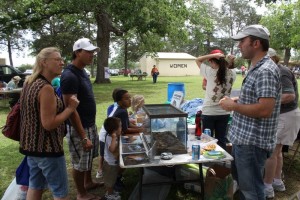
Houston Zoo Amphibian Program Manager Paul Crump meets a family attending the Milam County Nature Fest. The aquarium on the table holds Houston toad ‘ambassadors.’ More than 600 people attended the one day Nature Fest in Rockdale, Texas. (Photo courtesy of the Houston Zoo)
Learning about endangered species is the first step in helping to protect them.
In 1968, a small amphibian landed a spot on the list of “Rare and Endangered Fish and Wildlife of the United States.” Five years later, the Houston toad was included in the passing of the Endangered Species Act and became one of the first amphibian species in the United States, and maybe even the world, to be recognized as declining.
Today the Houston toad is no longer found in its namesake city, and fewer than 300 individuals remain in the wild, largely due to habitat loss. The Houston Zoo is working with the US Fish and Wildlife Service, Texas Parks and Wildlife Department, Texas State University and the Environmental Defense Fund to ensure the toad’s survival. The Zoo also works with private landowners to restore habitat and monitor populations in Houston toad counties. But before we can involve a landowner in the project we have to find them–and that’s where the Zoo’s education and outreach programs come in.
Mainstream media of course plays a major role in the effort. A recent front-page story in the Houston Chronicle highlighted the need for private landowners to participate in the restoration project. The article generated a dozen responses from interested landowners and raised the profile of the effort. But grassroots efforts also play an important role.
Through our collaboration with the US Fish and Wildlife Service and the Texas Parks and Wildlife Department, the Zoo has developed opportunities for the presentation of education and outreach programs in counties northwest of Houston, the Houston toad’s current range. In late February, a landowner workshop sponsored by Texas AgriLife Extension and the Texas Forest Service brought 200 landowners together to learn about woodland and pond management and how to get involved in the Houston toad recovery project. Recently, three members of the Houston Zoo Conservation Department participated in the Milam County Nature Fest 2012. Supported by the Texas Parks and Wildlife Department, the festival drew more than 600 participants from surrounding communities in prime Houston toad range for a day of nature exhibits and demonstrations, crafts and games for children and an opportunity to meet Houston toads and hear from those who are directly involved in the toad’s recovery.
It’s one thing to tell the world about the importance of amphibians to the balance of nature. It’s another thing entirely when you see the smile on a child’s face when they have an up-close encounter with an endangered species. Then you know you’ve connected.
–-Brian Hill, Houston Zoo
A United Front in Panama
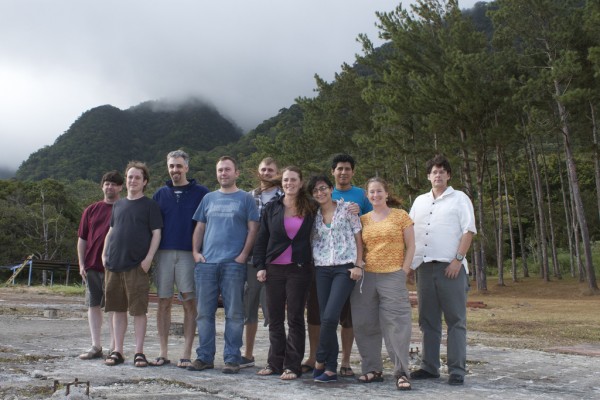
The Panama Amphibian Rescue and Conservation Project implementation team met in Panama in February. From left: Pete Riger, Alan Pessier, Eric Baitchman, Paul Crump, William, Heidi Ross-Griffth, Angie Estrada, Jorge Guerrel, Della Garelle, Roberto Ibanez (Photo by Brian Gratwicke, Smithsonian Conservation Biology Institute)
Amphibian conservationists convened in El Valle, Panama, last month to plan the future of our fight to save amphibians. We didn’t do any collecting this trip, as frogs are much harder to find during the dry season. Parts of the country, including past collection sites in the Darien region, are also currently too dangerous. Instead, members of the project’s implementation team met with the El Valle Amphibian Conservation Center (EVACC). We are joining forces and looking at ways we can work together as one organization with two campuses.
Dr. Alan Pessier of San Diego Zoo Global facilitated the two-and-a-half day strategic planning session where a SWOT analysis was used to identify the organizations’ combined Strengths, Weaknesses, Opportunities, and Threats. Participants included Heidi Ross, director of EVACC; Roberto Ibañez project director in country; Brian Gratwicke, project coordinator; Angie Estrada and Jorge Guerrel, project staff; Peter Riger and Paul Crump, Houston Zoo; Eric Baitchman, Zoo New England; Della Garelle, Cheyenne Mountain Zoo.
The outcome was an ambitious and detailed action plan to achieve our mutual goals of creating assurance colonies of Panama’s most vulnerable amphibian species, and ultimately re-establishing their healthy wild populations. We plan to expand our ability to house more priority species and breed them reliably, better communicate progress on our work to interested parties, continue to improve husbandry and increase efficiency, identify staffing and equipment needs, prioritize research projects, and develop re-introduction criteria.
—Dr. Della Garelle, Director of Conservation, Cheyenne Mountain Zoo


